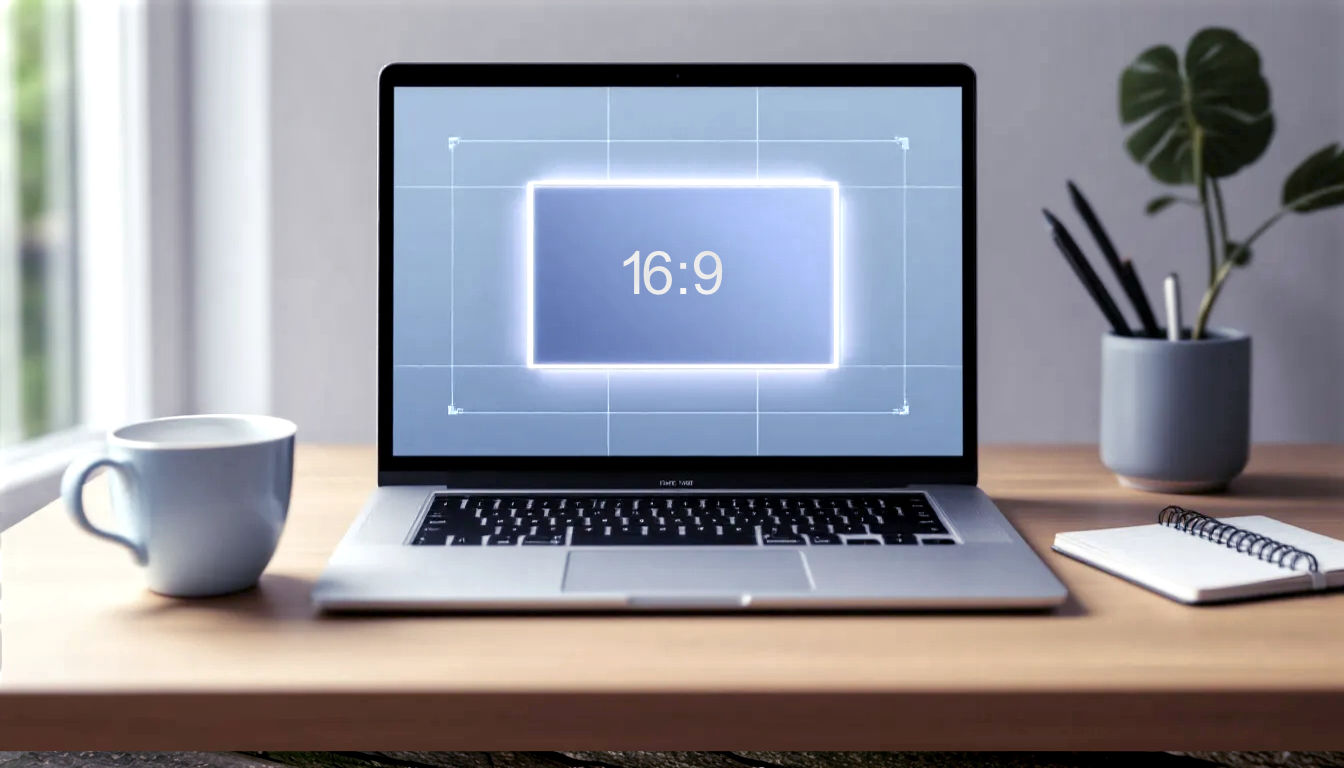A Web Designer’s Best Mate: The Complete Guide to CSS Aspect-Ratio
A complete guide to the CSS aspect-ratio property. Ditch the old padding-top hack and learn how this simple CSS rule makes responsive web design so much easier.

This post may contain affiliate links. If you make a purchase through these links, we may earn a commission at no additional cost to you.
Ever tried to fit a square peg in a round hole? That’s what web design often felt like before a handy little tool called aspect-ratio came along. For years, developers had to pull off all sorts of clever, and frankly, fiddly tricks just to make sure a video or an image didn’t end up looking stretched and squashed like a sad, deflated balloon on different-sized screens.
Imagine you’ve got a brilliant video of your dog catching a frisbee. On your laptop, it looks perfect. But on your phone, your prize-winning pooch suddenly looks ten feet tall and wafer-thin. Not a good look. This is the problem aspect-ratio solves. It’s a simple line of code that tells a box on a webpage: “Alright, mate, no matter how wide you get, always keep this specific shape.”
Whether it’s a perfect square for a profile picture, a widescreen rectangle for a YouTube video, or a portrait shape for a photo, aspect-ratio locks it in. It makes building websites that look great on any device—from a massive telly to a tiny smartphone—so much easier. It’s one of those simple ideas that makes you wonder how we ever managed without it.
This guide will walk you through everything. We’ll start with the basics, look at how it works its magic, and explore some real-world examples you can use on your own projects. Let’s get started.
What on Earth Is an Aspect Ratio Anyway?
Before we dive into the code, let’s get our heads around what an aspect ratio actually is. Don’t worry, it’s not as complicated as it sounds.
Think about the screen you’re looking at right now. It has a width and a height. The aspect ratio is simply the relationship between its width and its height.
We usually write it as two numbers separated by a colon, like width:height.
Let’s look at some common examples you’ll see every day:
- 1:1 (A Perfect Square): Think of an Instagram profile picture. Its width and height are exactly the same.
- 16:9 (Widescreen): This is the shape of most modern TVs and YouTube videos. It’s much wider than it is tall, making it great for watching films.
- 4:3 (Traditional TV): Remember the boxy TVs we had in the 90s? That was a 4:3 aspect ratio. It’s more square-like than modern screens.
- 3:2 (Classic Photography): Many digital cameras still use this ratio for photos. It’s a classic, balanced rectangle.
So, when we talk about the CSS aspect-ratio property, we’re talking about a tool that lets us tell any element on a webpage—a box, an image, a video player—to hold one of these shapes, no matter what.
Why Does It Matter for Web Design?
On the web, things are constantly changing size. A user might be on a huge desktop monitor, a medium-sized tablet, or a small phone held sideways. When a website adjusts to fit these different screens (a process we call responsive design), the boxes that hold content can stretch and shrink.
Without aspect-ratio, if you set a box to be 100% wide, its height would stay fixed. This can lead to some awkward results:
- Stretched Images: An image might look fine on a wide screen, but on a narrow phone screen, it gets squashed vertically.
- Black Bars on Videos: A video player might be forced into a shape that doesn’t match the video, leaving ugly black bars at the top and bottom or on the sides.
- Inconsistent Layouts: A grid of product images might look neat and tidy on one screen, but messy and uneven on another because the boxes have different heights.
The aspect-ratio property fixes all of this. It says, “I don’t care how wide this box gets; its height must always adjust to keep my shape.” This is a game-changer for creating fluid, consistent, and professional-looking websites.
The Old Days: Life Before aspect-ratio (The “Padding-Top Hack”)
To really appreciate how brilliant aspect-ratio is, we need to take a quick trip back in time. For years, web developers had a clever but slightly bonkers trick up their sleeves to maintain the shape of a box. It was known as the “padding-top hack,” and it was the go-to solution.
It worked, but it was a bit of a headache.
Here’s a simplified idea of how it was done. Imagine you wanted a box with a 16:9 aspect ratio. You would need two boxes: an outer one (the parent) and an inner one (the child).
- The Outer Box: You’d set its height to zero. Yes, zero!
- The “Magic” Padding: Then, you’d add padding to the top of the outer box. The amount of padding was calculated with a bit of maths:
(height / width) * 100%.- For a 16:9 ratio, the calculation is
(9 / 16) * 100% = 56.25%. So, you’d setpadding-top: 56.25%.
- For a 16:9 ratio, the calculation is
- The Inner Box: You’d place your actual content (like an image or video) inside a second box. This inner box would be positioned to sit perfectly inside the padded area of the outer box.
Here’s what the code looked like:
.aspect-ratio-box-outer {
position: relative;
height: 0;
padding-top: 56.25%; /* This creates the 16:9 shape */
}
.aspect-ratio-box-inner {
position: absolute;
top: 0;
left: 0;
width: 100%;
height: 100%;
}
Why Was This Such a Faff?
The padding-top hack was clever, but it had downsides:
- It Was Complicated: You needed extra HTML elements and a bunch of CSS that wasn’t very intuitive. Explaining to a newcomer why padding was creating height was always a bit weird.
- It Required Maths: You had to calculate the percentage for every aspect ratio you wanted. Not difficult maths, but still an extra step.
- It Was a “Hack”: It felt like a workaround because it was. We were using the padding property for something it was never really designed for.
It was the best tool we had for a long time, and it saved the day on many projects. But thankfully, we now have a much cleaner, simpler, and more direct way of doing things.
Introducing the aspect-ratio Property: A New Era
The CSS aspect-ratio property is wonderfully simple. It lets you define the desired shape of an element with a single line of code. No more hacks, no more extra boxes, no more weird maths.
You just tell it the ratio you want.
How to Use It: The Syntax
The syntax is as straightforward as it gets. You just write aspect-ratio: followed by the ratio you need.
.my-box {
aspect-ratio: 16 / 9;
}
You can write the ratio in a few ways:
- With a Slash:
16 / 9is the most common and readable way. The browser does the maths for you. - As a Single Number: You can also use a single number, which is the result of dividing the width by the height. For example,
aspect-ratio: 1.7777;is the same as16 / 9. - The
autoValue: The default value isauto, which means the element doesn’t have a preferred aspect ratio. It will behave as normal.
Let’s look at a few examples for different shapes:
/* A perfect square */
.square-profile-pic {
width: 150px;
aspect-ratio: 1 / 1;
}
/* A widescreen video container */
.widescreen-video {
width: 100%;
aspect-ratio: 16 / 9;
}
/* A portrait-oriented photo */
.portrait-photo {
width: 300px;
aspect-ratio: 2 / 3;
}
In each of these examples, you only need to set the width. The browser will automatically calculate the correct height to maintain the aspect ratio. If you were to set the height instead, the browser would calculate the width. It’s beautifully flexible.
How Does It Interact with Other CSS Properties?
The aspect-ratio property is designed to work smoothly with other parts of CSS, but it’s good to know the rules of the game.
widthandheight: If you set awidth(ormax-width),aspect-ratiowill control the height. If you set aheight, it will control the width.- What if you set
width,height, ANDaspect-ratio? If thewidthandheightyou provide already match theaspect-ratio, then everything is fine. But if they conflict (e.g., you setwidth: 200px; height: 100px;andaspect-ratio: 1 / 1;), theaspect-ratiowill usually be ignored. The fixedwidthandheighttake priority. - Content Can Override It: What if you have content inside the box that’s too big to fit? For example, a tall block of text inside a widescreen
16:9box. By default, the box will stretch to make room for the content, ignoring theaspect-ratio. This is usually what you want, as it prevents your content from spilling out. - Images and Videos: For elements that already have a natural aspect ratio (like an
<img>or<video>tag), theaspect-ratioproperty can work with them. If you only provide awidthfor an image, the browser will use the image’s own aspect ratio to figure out the height. But you can use the CSSaspect-ratioto override it if you need to.
This new property makes our code cleaner and our intentions clearer. It’s a huge step forward for responsive design.
Practical Applications: Where to Use aspect-ratio
Now for the fun part. Let’s look at some real-world situations where the aspect-ratio property is incredibly useful. These are the kinds of tasks that used to be a pain but are now a piece of cake.
1. Responsive Video Embeds
This is one of the most common and satisfying uses for aspect-ratio. When you embed a video from a site like YouTube or Vimeo, it comes in an <iframe>. You want this video player to fill the width of its container but keep its 16:9 shape.
The Old Way (Padding-Top Hack):
<div class="video-container-hack">
<iframe src="[https://www.youtube.com/embed/dQw4w9WgXcQ](https://www.youtube.com/embed/dQw4w9WgXcQ)" frameborder="0"></iframe>
</div>
.video-container-hack {
position: relative;
padding-bottom: 56.25%; /* 16:9 */
height: 0;
}
.video-container-hack iframe {
position: absolute;
top: 0;
left: 0;
width: 100%;
height: 100%;
}
The New Way (aspect-ratio):
<iframe class="video-new" src="[https://www.youtube.com/embed/dQw4w9WgXcQ](https://www.youtube.com/embed/dQw4w9WgXcQ)" frameborder="0"></iframe>
.video-new {
width: 100%;
aspect-ratio: 16 / 9;
}
Look at how much cleaner that is! The HTML is simpler, and the CSS is reduced to just two lines. It’s more direct and easier for anyone to understand.
2. Consistent Product Grids
Imagine you’re building an e-commerce site for a clothing brand. You have a gallery of T-shirts. Some photos are portrait, and some are landscape. If you just put them in a grid, the different heights will make the layout look messy and uneven.
By using aspect-ratio, you can force every product image container to be a perfect square (1:1). This creates a clean, uniform grid that’s pleasing to the eye.
<div class="product-grid">
<div class="product-card">
<img src="tshirt1.jpg" alt="Blue T-shirt">
<h3>Cool Blue Tee</h3>
</div>
<div class="product-card">
<img src="tshirt2.jpg" alt="Red T-shirt">
<h3>Rad Red Tee</h3>
</div>
</div>
.product-card {
aspect-ratio: 1 / 1;
}
.product-card img {
width: 100%;
height: 100%;
object-fit: cover; /* This makes the image fill the box without stretching */
}
By adding object-fit: cover; to the image itself, we ensure the image fills the square box without being distorted. It might crop a little bit of the top and bottom or sides, but that’s usually a good trade-off for a beautiful, consistent layout.
3. Hero Banners and Feature Images
Many websites have a large “hero” image or banner at the top of the homepage. You might want this banner to have a specific cinematic feel, maybe a 21/9 ratio. Or perhaps you want a feature image in an article to always be 3/2.
Using aspect-ratio ensures that these key visual elements maintain their intended composition and impact, no matter the screen size.
.hero-banner {
width: 100%;
aspect-ratio: 21 / 9;
background-image: url('epic-hero-image.jpg');
background-size: cover;
background-position: center;
}
4. Preventing Layout Shift
Have you ever been reading an article online when suddenly an image loads and all the text jumps down the page? It’s really annoying. This is called Cumulative Layout Shift (CLS), and it’s something Google measures as part of its Core Web Vitals, which can affect a site’s search ranking.
CLS often happens when the browser doesn’t know how much space an image will take up until it has finished downloading.
aspect-ratio is a fantastic tool for preventing this. By setting an aspect-ratio on an image container (along with a width), you are telling the browser exactly what shape the box will be. The browser can then reserve that space in the layout before the image has even started loading.
<img src="my-image.jpg" width="800" height="600" style="width: 100%; height: auto;">
In modern browsers, if you set the width and height attributes directly in the HTML, the browser will calculate the aspect ratio from them and reserve the space. Combining this with CSS width: 100%; height: auto; makes images responsive while preventing layout shift. The CSS aspect-ratio property is another powerful way to achieve this explicitly for any element, not just images.
Browser Support and Looking to the Future
One of the most important questions for any new CSS feature is: “Can I actually use it?”
For aspect-ratio, the answer is a resounding yes!
As of today, the aspect-ratio property is supported by all major modern browsers:
- Chrome (since version 88)
- Firefox (since version 85)
- Safari (since version 15)
- Edge (since version 88)
This covers the vast majority of web users. This means you can confidently start using aspect-ratio in your projects today without worrying about it breaking for most people.
What About Older Browsers?
Of course, there will always be a small number of users on very old browsers that don’t support aspect-ratio. So, what happens for them?
If a browser doesn’t understand aspect-ratio, it will simply ignore that line of code. This means your layout might not look as good, but it shouldn’t completely break the website. The element will just fall back to its default behaviour.
If you absolutely need to support older browsers and maintain the aspect ratio, you have a few options:
- Use the Padding-Top Hack as a Fallback: You can use modern CSS features like
@supportsto check if the browser understandsaspect-ratio. If it doesn’t, you can apply the old padding-top hack instead..my-box { width: 100%; aspect-ratio: 16 / 9; /* For modern browsers */ } @supports not (aspect-ratio: 16 / 9) { .my-box { /* Fallback using the padding-top hack */ position: relative; height: 0; padding-top: 56.25%; } } - Decide if it’s a Big Deal: In many cases, it might be acceptable for the layout to be slightly less perfect on an old browser. This is a concept called progressive enhancement. You build a solid foundation that works everywhere, then add the shiny new features for users on modern browsers. For something like a decorative image, this is often a perfectly reasonable approach.
The Future is Ratio-Driven
The arrival of aspect-ratio is part of a bigger shift in web design. We’re moving away from fixed, pixel-perfect layouts and towards more fluid, component-based systems that can adapt to any screen.
Features like aspect-ratio, along with CSS Grid and Flexbox, give designers and developers powerful tools to build layouts that are more resilient, predictable, and easier to maintain. As new devices with different screen shapes and sizes continue to appear, having a simple, reliable way to control the shape of our content will only become more important.
Final Thoughts: Why aspect-ratio is a Game-Changer
It’s not often that a single line of CSS comes along and solves a problem that has bothered developers for over a decade. But aspect-ratio does exactly that.
It takes a complex, hacky solution and replaces it with a simple, elegant, and intuitive command.
- It’s Cleaner: Our code is shorter, easier to read, and makes more sense.
- It’s More Robust: It’s the official, standard way to do things, meaning it’s reliable and here to stay.
- It Improves User Experience: By helping to prevent layout shift and creating more consistent designs, it makes websites better for everyone.
- It Frees Us Up to Be Creative: By taking care of the tedious mechanics of responsive shapes, it lets us focus on the more interesting parts of design and development.
So, next time you’re building a website and need to control the shape of an element, don’t reach for the old padding-top hack. Embrace the simplicity and power of aspect-ratio. It’s a small property that makes a massive difference, and it’s a brilliant example of how CSS is constantly evolving to make building for the web a better experience.
Further Reading
To dive even deeper, check out these excellent resources from trusted web development authorities:
- MDN Web Docs on
aspect-ratio: The definitive technical reference. MDN aspect-ratio page - CSS-Tricks’ Guide: A practical and well-explained article on the property. CSS-Tricks on aspect-ratio
- Smashing Magazine: In-depth articles on modern CSS and web design practices. Smashing Magazine
- web.dev by Google: Articles on performance and modern web capabilities, including Core Web Vitals. web.dev






